产后出血危重病人交接班流程
产后出血应急预案过程

一、背景产后出血是指胎儿娩出后24小时内,阴道出血量超过500ml,剖宫产时超过1000ml。
产后出血是分娩期严重的并发症,也是导致孕产妇死亡的主要原因之一。
为提高抢救成功率,保障母婴安全,制定本应急预案。
二、应急预案启动条件1. 产后2小时内,阴道出血量超过400ml;2. 产后出血原因不明,病情危重;3. 出血量迅速增加,生命体征不稳定;4. 医护人员认为有必要启动应急预案的情况。
三、应急预案流程1. 立即通知医生发现产后出血情况后,立即通知值班医生,并简要说明出血情况、产妇生命体征及病史。
2. 吸氧、建立静脉通道给予产妇吸氧,并迅速建立两条畅通的静脉通道,为抢救提供充足的液体支持。
3. 监测生命体征密切监测产妇的血压、脉搏、呼吸、体温等生命体征,及时记录。
4. 实施止血措施根据出血原因,采取相应的止血措施:(1)宫缩乏力:加强宫缩,使用缩宫素、米索前列醇等药物,必要时进行宫腔填塞。
(2)软产道裂伤:立即进行缝合止血。
(3)胎盘因素:协助医生处理胎盘,如胎盘剥离不全,可行胎盘剥离术。
(4)子宫破裂:协助医生进行子宫修补术。
5. 补充血容量根据失血量,遵医嘱给予补充血容量,如输血、血浆、代血浆等。
6. 抗休克治疗根据病情,给予抗休克治疗,如使用血管活性药物、利尿剂等。
7. 监测病情变化密切观察产妇的生命体征、出血量、宫缩情况等,及时调整治疗方案。
8. 术前准备若需进行手术,协助医生做好术前准备,如备皮、备血、输血等。
9. 抢救记录详细记录抢救过程,包括用药、输血、手术等,为后续治疗提供依据。
10. 病情稳定后,转入病房产妇病情稳定后,遵医嘱转入病房,与当班护士做好病情交接。
四、应急预案总结1. 产后出血的抢救需要医护人员密切配合,迅速、准确地进行各项操作。
2. 早期识别产后出血的预警信号,及时采取干预措施,降低产后出血的发生率。
3. 加强产后出血的预防意识,提高医护人员对产后出血的认识和应急处理能力。
危重患者交接流程
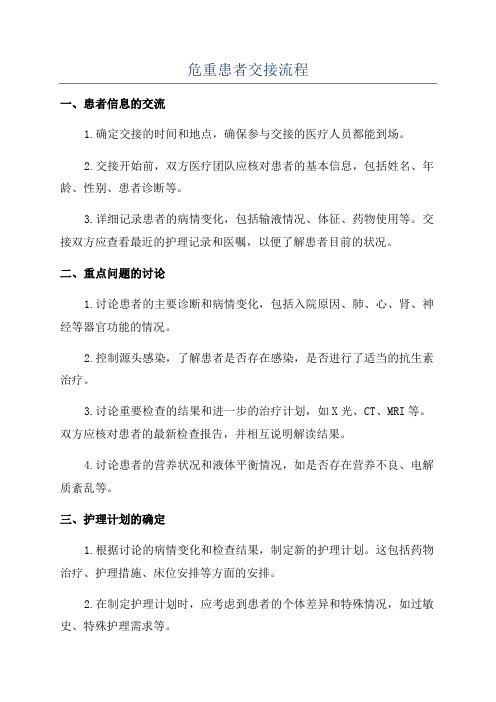
危重患者交接流程一、患者信息的交流1.确定交接的时间和地点,确保参与交接的医疗人员都能到场。
2.交接开始前,双方医疗团队应核对患者的基本信息,包括姓名、年龄、性别、患者诊断等。
3.详细记录患者的病情变化,包括输液情况、体征、药物使用等。
交接双方应查看最近的护理记录和医嘱,以便了解患者目前的状况。
二、重点问题的讨论1.讨论患者的主要诊断和病情变化,包括入院原因、肺、心、肾、神经等器官功能的情况。
2.控制源头感染,了解患者是否存在感染,是否进行了适当的抗生素治疗。
3.讨论重要检查的结果和进一步的治疗计划,如X光、CT、MRI等。
双方应核对患者的最新检查报告,并相互说明解读结果。
4.讨论患者的营养状况和液体平衡情况,如是否存在营养不良、电解质紊乱等。
三、护理计划的确定1.根据讨论的病情变化和检查结果,制定新的护理计划。
这包括药物治疗、护理措施、床位安排等方面的安排。
2.在制定护理计划时,应考虑到患者的个体差异和特殊情况,如过敏史、特殊护理需求等。
3.交接双方应共同确认护理计划的合理性和可行性,并在交接记录中进行记录。
四、沟通反馈1.交接结束后,双方医疗团队应归档患者的交接记录,并确保记录完整准确。
2.在患者交接记录中写明双方的签名和日期,表明交接的完成和同意。
3.交接人员应向本人显示了解并提问,以确保信息的准确性。
危重患者交接流程的关键是确保信息的准确传递和沟通的有效性。
只有通过良好的交接流程,才能保证医疗团队之间的协作和连续的护理。
此外,更紧张、复杂或特殊情况下,可能需要进一步的措施,如实地观察,参与其他专业人员,进行细致的讨论和交流,并进行必要的再次交接。
县医院产科危重孕产妇抢救服务流程

县医院产科危重孕产妇抢救服务流程产科危重孕产妇抢救服务流程1.成立产科危重孕产妇抢救小组,负责危重孕产妇抢救的组织和实施。
组长:院长、业务副院长副组长:医务科长、产科主任、产科护士长成员:产科全体医护人员及相关科室人员2.严格执行高危孕产妇重点加强原则。
(1)值班医护人员120救援电话后,应详细询问记录病人情况,出诊接诊的医护人员要携带抢救药品、氧气、产包等器械,产后大出血的,要询问血型并通知检验科备血。
赶往现场后立即实施紧急抢救措施。
能转院的尽力转回医院抢救,在车上仍要继续采取必要的抢救措施。
不能转院的要就地组织抢救并通知医院和科室抢救小组,以便进行增援。
对需要输血而又不能转院者,备血后由检验科安排人员携带血液送达抢救现场。
要转回本院的,通知科室抢救小组组长和小组成员以做好接应和抢救准备工作。
(2)门诊发现危重孕产妇要马上通知病房做好抢救准备工作,接诊医生要亲自护送孕产妇到病房。
(3)病房日常分娩的产妇,要严密观察病情,有危重病情发展趋向的,应当及时诊治和组织抢救。
对入院待产的高危孕产妇,入院时要制订治疗方案,并根据病情变化及时调整和及时组织抢救。
3.救护车接诊产妇,回院后直接送到科室进行抢救。
抢救小组人员接到通知后要快速到达科室,不得有误。
各有关人员要坚守岗位,以便及时抢救。
孕产妇到院后立即进入抢救程序,抢救小组以科主任为现场指挥。
由抢救小组及值班人员根据病情确定抢救方案。
需要科间会诊的,应当及时请相关科室会诊。
必要时通知医务科或医院急救工作领导小组进行组织、协调、参加抢救。
4.参加抢救的医护人员要服从指挥、密切配合、分工负责、通力合作、规范操作。
要严格执行查对制度,口头医嘱要求准确无误、清楚,护士要复述一遍,以免发生差错,必须注明执行时间。
严密观察病情,认真及时做好各种记录。
由一名人员认真书写医疗文书,记录各种治疗方案、方法、医嘱。
各种记录要求准确无误、清晰明了、扼要完整,而且必须注明时间。
产后出血的应急预案演练流程
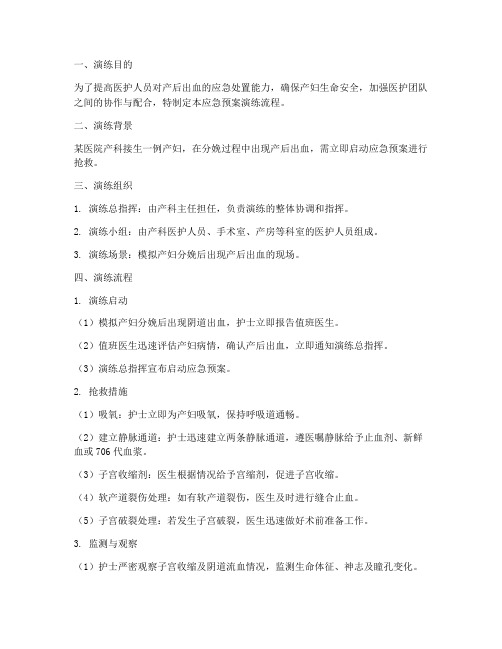
一、演练目的为了提高医护人员对产后出血的应急处置能力,确保产妇生命安全,加强医护团队之间的协作与配合,特制定本应急预案演练流程。
二、演练背景某医院产科接生一例产妇,在分娩过程中出现产后出血,需立即启动应急预案进行抢救。
三、演练组织1. 演练总指挥:由产科主任担任,负责演练的整体协调和指挥。
2. 演练小组:由产科医护人员、手术室、产房等科室的医护人员组成。
3. 演练场景:模拟产妇分娩后出现产后出血的现场。
四、演练流程1. 演练启动(1)模拟产妇分娩后出现阴道出血,护士立即报告值班医生。
(2)值班医生迅速评估产妇病情,确认产后出血,立即通知演练总指挥。
(3)演练总指挥宣布启动应急预案。
2. 抢救措施(1)吸氧:护士立即为产妇吸氧,保持呼吸道通畅。
(2)建立静脉通道:护士迅速建立两条静脉通道,遵医嘱静脉给予止血剂、新鲜血或706代血浆。
(3)子宫收缩剂:医生根据情况给予宫缩剂,促进子宫收缩。
(4)软产道裂伤处理:如有软产道裂伤,医生及时进行缝合止血。
(5)子宫破裂处理:若发生子宫破裂,医生迅速做好术前准备工作。
3. 监测与观察(1)护士严密观察子宫收缩及阴道流血情况,监测生命体征、神志及瞳孔变化。
(2)医生及时调整治疗方案,根据病情变化采取有效措施。
4. 心理护理(1)护士对产妇进行心理疏导,安慰产妇,减轻其紧张情绪。
(2)医生与护士共同关注产妇的心理需求,提供心理支持。
5. 交接班(1)病情稳定后,遵医嘱将产妇送回病房,与当班护士病情交接并做记录。
(2)医生、护士共同总结本次抢救过程,分析存在的问题,提出改进措施。
6. 演练总结(1)演练结束后,演练总指挥组织全体参演人员召开总结会议。
(2)参演人员对演练过程进行自我评价,提出改进意见。
(3)演练总指挥对本次演练进行总结,指出存在的问题,提出改进措施。
五、演练要求1. 参演人员应熟悉应急预案内容,明确各自职责。
2. 演练过程中,医护人员应保持冷静、有序,紧密配合。
产后出血患者的应急预案及程序

产后出血患者的应急预案及程序【应急预案】(一)立即报告上级医师或科主任,吸氧、补充血容量,使用静脉留置针或选用大针头,必要时建立两条静脉通道。
(二)静脉给予各种止血剂、新鲜血或706 代血浆。
如患者继续出血,出血量> 1 000ml,心率> 120/ min,血压< 80/50mmHg,且神志恍惚、四肢厥冷,说明患者已出现失血性休克,应迅速开放静脉输液,作腔静脉插管。
(三)备好各种抢救药物及器械,如为子宫收缩乏力,及时应用宫缩剂,如为软产道裂伤,及时配合缝合止血。
(四)若发生子宫破裂,迅速做好术前准备工作。
(五)当班者应严密观察子宫收缩及阴道流血情况,严密观察产妇生命体征、神志及瞳孔变化,及时发现异常,采取有效措施。
(六)病情稳定后,遵医嘱送回病房,与当班医生病情交接并做好记录。
【程序】立即通知上级医生或科主任→ 吸氧→ 建立静脉通道→ 配合抢救→ 保持呼吸道通畅→ 做好术前准备→ 观察病情变化→ 严格交班→ 记录抢救过程宫外孕失血性休克的应急预案及程序【应急预案】(一)立即通知上级医生或科主任的同时,给予抗休克处理,置患者头部抬高15°,下肢抬高20°。
(二)迅速扩容,选择9~16 号针头快速进行静脉穿刺,若因失血多,血管瘪陷难穿刺者,立即行静脉切开术,保证液体的充分补充。
(三)氧气吸人,吸氧过程中注意保持患者呼吸道通畅,及时观察生命体征和给氧效果。
氧流量调至2~4L/min。
(四)严密观察病情变化,每10 ~30 min 测量体温、脉搏、呼吸、血压一次,认真观察患者意识改变,皮肤粘膜的颜色、温度、尿量的变化。
若脉搏、呼吸快而急促, 血压在12 kPa 以下,躁动不安,尿量少,考虑液体量不足,此时应加快补液。
(五)积极做好后穹隆穿刺,尿试验等辅助检查,以明确诊断,避免因误诊而延误病情。
(六)术前准备:抗休克的同时,必须及时做好术前准备,按剖腹探查术前准备对待,抽血送实验室急查血常规、出凝血时间,备皮、配血、留置尿管等,尽快护送患者进手术室。
产后出血患者的应急预案及程序
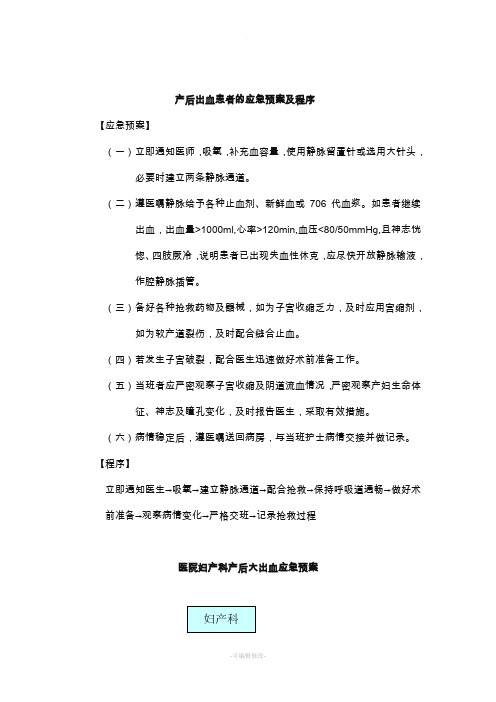
产后出血患者的应急预案及程序【应急预案】(一)立即通知医师,吸氧,补充血容量,使用静脉留置针或选用大针头,必要时建立两条静脉通道。
(二)遵医嘱静脉给予各种止血剂、新鲜血或706代血浆。
如患者继续出血,出血量>1000ml,心率>120min,血压<80/50mmHg,且神志恍惚、四肢厥冷,说明患者已出现失血性休克,应尽快开放静脉输液,作腔静脉插管。
(三)备好各种抢救药物及器械,如为子宫收缩乏力,及时应用宫缩剂,如为软产道裂伤,及时配合缝合止血。
(四)若发生子宫破裂,配合医生迅速做好术前准备工作。
(五)当班者应严密观察子宫收缩及阴道流血情况,严密观察产妇生命体征、神志及瞳孔变化,及时报告医生,采取有效措施。
(六)病情稳定后,遵医嘱送回病房,与当班护士病情交接并做记录。
【程序】立即通知医生→吸氧→建立静脉通道→配合抢救→保持呼吸道通畅→做好术前准备→观察病情变化→严格交班→记录抢救过程医院妇产科产后大出血应急预案妇产科有高危因素汇报主任产前评估与产前检查确定分娩方式(经阴道或剖宫产)按摩宫底,观察宫缩,判断出血量开放静脉,输液,监测血压,备血备好血源至少1.5-3单位检验中心汇报上级医师与科主任,15分钟内或出血量在750ml 内到场发现不凝血检验科30分钟内完成相关检查并配好血等待输血扩容 吸氧 心电监护 两路静脉≥200ml≥500ml发现面苍、全身出冷汗血压迅速下降出血达到1000ml (800?)时1000ml 之前输上血制品根据患者具体情况由上级医师或科主任汇报总值班,安排全院抢救专家组会诊。
科室决定是否手术治疗。
查找原因 据因处理 (按摩、压迫、宫腔填塞等)血常规 凝血功能 交叉配血术中出血大于500且有上升趋势立即通知检验科配血继续出血补液量至少1000产后观察继续出血保守无效继续出血1500ml 之前输上冷沉淀、血小板,输上冷沉淀至少需2小时,妇产科必须提前通报检验科注:1 启动输血绿色通道时机,由妇产科决定、签字并负责事后补办相关手续(输血费、保证金等)。
【原创】危急重症患者床旁交接规范流程和注意事项

危急重症患者床旁交接的规范流程和注意事项一、规范流程1. 交接准备-接班护士提前熟悉患者的病历资料,包括诊断、病情、治疗方案等。
-确保交接时所需的医疗设备和物品齐全,如监护仪、输液泵、急救药品等处于良好备用状态。
2. 到达床旁-交班护士、接班护士、医生共同前往患者床旁。
3. 病情交接-交班护士向接班护士详细介绍患者的基本信息,如姓名、年龄、诊断。
-重点说明患者当前的生命体征,包括体温、心率、呼吸频率、血压、血氧饱和度等。
-描述患者的意识状态、瞳孔大小及对光反射情况。
-汇报患者的症状和体征,如疼痛部位、程度,皮肤状况等。
4. 治疗交接-告知正在进行的治疗措施,如输液的药物及速度、吸氧的流量、使用的血管活性药物及剂量等。
-介绍各种引流管的情况,包括引流液的颜色、性质、量,以及引流管的固定和通畅情况。
-说明患者已完成和即将进行的检查项目。
5. 护理交接-分享特殊的护理要点,如皮肤护理、口腔护理、体位护理等。
-交代患者的心理状态和护理需求。
6. 仪器设备交接-展示并介绍正在使用的仪器设备,如监护仪、呼吸机、除颤仪等的参数设置和运行情况。
-确保接班护士熟悉仪器设备的操作和报警处理。
7. 物品交接-清点患者身边的物品,如病历、护理记录单、生活用品等。
8. 沟通交流-接班护士在听取交班后,如有疑问及时提出,确保清楚了解患者的情况。
-医生补充相关的医疗指示和注意事项。
9. 记录签名-交接完成后,接班护士在护理记录单上记录交接情况,并签名确认。
二、注意事项1. 交接过程中要保持严谨、认真的态度,确保信息准确无误。
2. 注意保护患者的隐私,避免在交接时大声讨论敏感信息。
3. 交接时动作轻柔,避免因操作不当给患者带来不适或影响病情。
4. 对患者的病情变化要有敏锐的观察力,及时发现潜在问题。
5. 严格按照护理操作规程进行交接,如检查管道固定是否牢固、有无滑脱风险等。
6. 对于不清楚或有疑问的地方,务必当场核实清楚,不能凭主观猜测。
产后出血应急演练预案及流程
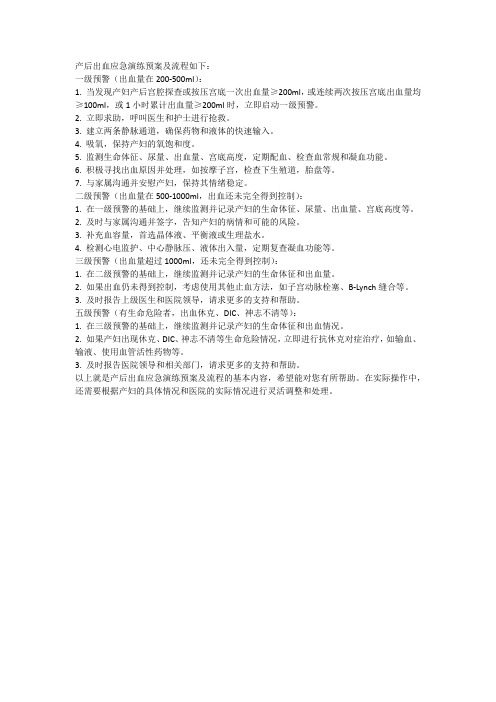
产后出血应急演练预案及流程如下:一级预警(出血量在200-500ml):1. 当发现产妇产后宫腔探查或按压宫底一次出血量≥200ml,或连续两次按压宫底出血量均≥100ml,或1小时累计出血量≥200ml时,立即启动一级预警。
2. 立即求助,呼叫医生和护士进行抢救。
3. 建立两条静脉通道,确保药物和液体的快速输入。
4. 吸氧,保持产妇的氧饱和度。
5. 监测生命体征、尿量、出血量、宫底高度,定期配血、检查血常规和凝血功能。
6. 积极寻找出血原因并处理,如按摩子宫,检查下生殖道,胎盘等。
7. 与家属沟通并安慰产妇,保持其情绪稳定。
二级预警(出血量在500-1000ml,出血还未完全得到控制):1. 在一级预警的基础上,继续监测并记录产妇的生命体征、尿量、出血量、宫底高度等。
2. 及时与家属沟通并签字,告知产妇的病情和可能的风险。
3. 补充血容量,首选晶体液、平衡液或生理盐水。
4. 检测心电监护、中心静脉压、液体出入量,定期复查凝血功能等。
三级预警(出血量超过1000ml,还未完全得到控制):1. 在二级预警的基础上,继续监测并记录产妇的生命体征和出血量。
2. 如果出血仍未得到控制,考虑使用其他止血方法,如子宫动脉栓塞、B-Lynch缝合等。
3. 及时报告上级医生和医院领导,请求更多的支持和帮助。
五级预警(有生命危险者,出血休克、DIC、神志不清等):1. 在三级预警的基础上,继续监测并记录产妇的生命体征和出血情况。
2. 如果产妇出现休克、DIC、神志不清等生命危险情况,立即进行抗休克对症治疗,如输血、输液、使用血管活性药物等。
3. 及时报告医院领导和相关部门,请求更多的支持和帮助。
以上就是产后出血应急演练预案及流程的基本内容,希望能对您有所帮助。
在实际操作中,还需要根据产妇的具体情况和医院的实际情况进行灵活调整和处理。
产后出血抢救流程

产后出血抢救流程产后出血是指产后24小时内大量阴道出血,是产后最常见的急性并发症之一,严重时可危及产妇生命。
因此,对产后出血的抢救流程非常重要,下面将详细介绍产后出血抢救的流程。
1. 快速评估,当产妇出现产后出血症状时,医护人员首先需要快速评估产妇的病情,包括出血量、血压、脉搏、呼吸等生命体征,以确定出血的严重程度。
2. 紧急处理,在评估的基础上,医护人员应立即进行紧急处理,包括停止出血源、维持循环、输血等措施。
停止出血源的方法包括子宫按摩、宫颈夹紧、宫颈缝合等,以尽快止血。
3. 输血输液,对于产后出血严重的产妇,需要及时输血输液,以维持血容量和循环稳定。
输血输液的种类和数量应根据产妇的具体情况来确定,确保及时有效地补充失血量。
4. 监测观察,在抢救过程中,医护人员需要对产妇的生命体征进行持续监测观察,包括血压、脉搏、呼吸、意识等指标,及时发现并处理可能出现的并发症。
5. 手术处理,对于无法通过药物和其他措施控制的产后出血,可能需要进行手术处理,包括子宫动脉 ligation、子宫切除术等,以彻底止血。
6. 术后护理,产后出血抢救结束后,产妇需要进行术后护理,包括密切观察病情变化、定期复查、避免感染等,以确保产妇的康复和健康。
总之,对产后出血的抢救流程需要医护人员具备丰富的临床经验和敏锐的判断能力,能够迅速、有效地处理产妇的病情,最大限度地保护产妇的生命安全。
同时,产妇本人及其家属也应了解产后出血的抢救流程,及时寻求医疗帮助,以减少不必要的伤害。
希望通过本文的介绍,能够增加大家对产后出血抢救流程的了解,提高对产后出血的处理能力,保障产妇的健康和安全。
产后出血应急预案流程

一、背景产后出血是孕产妇常见的严重并发症,严重威胁孕产妇的生命安全。
为提高孕产妇的抢救成功率,确保孕产妇的生命安全,特制定本应急预案流程。
二、组织机构1. 急诊科:负责接收产后出血患者,进行初步救治。
2. 妇产科:负责产后出血患者的进一步救治和手术处理。
3. 麻醉科:负责为产后出血患者提供麻醉服务。
4. 血液科:负责为产后出血患者提供血液制品。
5. ICU:负责对危重产后出血患者进行重症监护。
6. 护理部:负责协调各部门的救治工作。
三、应急预案流程1. 初步救治(1)急诊科接收产后出血患者后,立即通知妇产科、麻醉科、血液科等相关科室。
(2)对产妇进行生命体征监测,包括心率、血压、呼吸、体温等。
(3)建立两条可靠的静脉通道,保证输液和输血。
(4)给予产妇吸氧,维持呼吸道通畅。
(5)遵医嘱给予止血药物、新鲜血液或血浆等。
2. 进一步救治(1)妇产科医生接诊后,对产妇进行全面检查,评估出血原因。
(2)根据出血原因,采取相应的救治措施,如按摩子宫、宫腔填塞、缝合止血等。
(3)若病情严重,需进行手术处理,如子宫切除、宫腔镜手术等。
(4)麻醉科为手术患者提供麻醉服务。
(5)血液科为患者提供血液制品,确保输血安全。
3. 重症监护(1)将危重产后出血患者转入ICU进行重症监护。
(2)监测患者生命体征、出入量、凝血功能等指标。
(3)根据病情变化,调整治疗方案。
4. 抢救记录(1)详细记录抢救过程,包括病情变化、用药情况、手术操作等。
(2)及时向患者家属告知病情,取得家属配合。
四、应急响应1. 当产后出血患者数量超过科室救治能力时,立即启动应急预案。
2. 护理部协调各部门,确保抢救工作顺利进行。
3. 向院领导报告,启动院内抢救小组,多科室协同抢救。
4. 及时与患者家属沟通,做好抢救记录。
五、总结本应急预案流程旨在提高产后出血的救治成功率,确保孕产妇的生命安全。
各部门应加强协作,提高应急处理能力,确保孕产妇的身心健康。
危重病人交接流程
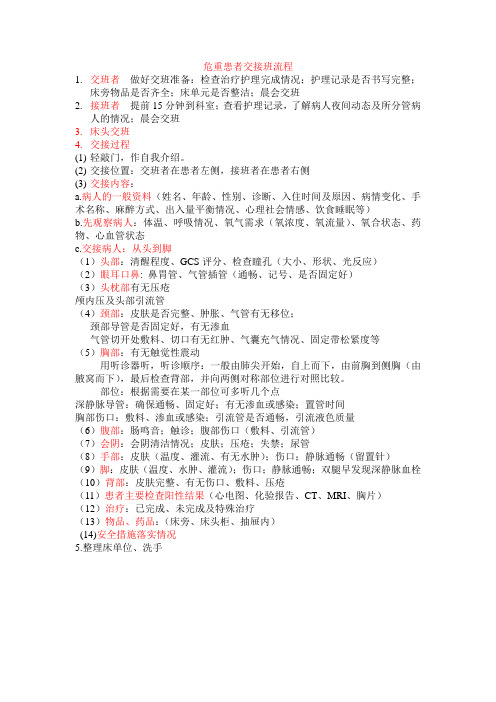
危重患者交接班流程1.交班者做好交班准备:检查治疗护理完成情况;护理记录是否书写完整;床旁物品是否齐全;床单元是否整洁;晨会交班2.接班者提前15分钟到科室;查看护理记录,了解病人夜间动态及所分管病人的情况;晨会交班3.床头交班4.交接过程(1)轻敲门,作自我介绍。
(2)交接位置:交班者在患者左侧,接班者在患者右侧(3)交接内容:a.病人的一般资料(姓名、年龄、性别、诊断、入住时间及原因、病情变化、手术名称、麻醉方式、出入量平衡情况、心理社会情感、饮食睡眠等)b.先观察病人:体温、呼吸情况、氧气需求(氧浓度、氧流量)、氧合状态、药物、心血管状态c.交接病人:从头到脚(1)头部:清醒程度、GCS评分、检查瞳孔(大小、形状、光反应)(2)眼耳口鼻: 鼻胃管、气管插管(通畅、记号、是否固定好)(3)头枕部有无压疮颅内压及头部引流管(4)颈部:皮肤是否完整、肿胀、气管有无移位;颈部导管是否固定好,有无渗血气管切开处敷料、切口有无红肿、气囊充气情况、固定带松紧度等(5)胸部:有无触觉性震动用听诊器听,听诊顺序:一般由肺尖开始,自上而下,由前胸到侧胸(由腋窝而下),最后检查背部,并向两侧对称部位进行对照比较。
部位:根据需要在某一部位可多听几个点深静脉导管:确保通畅、固定好;有无渗血或感染;置管时间胸部伤口:敷料、渗血或感染;引流管是否通畅,引流液色质量(6)腹部:肠鸣音;触诊;腹部伤口(敷料、引流管)(7)会阴:会阴清洁情况;皮肤;压疮;失禁;尿管(8)手部:皮肤(温度、灌流、有无水肿);伤口;静脉通畅(留置针)(9)脚:皮肤(温度、水肿、灌流);伤口;静脉通畅;双腿早发现深静脉血栓(10)背部:皮肤完整、有无伤口、敷料、压疮(11)患者主要检查阳性结果(心电图、化验报告、CT、MRI、胸片)(12)治疗:已完成、未完成及特殊治疗(13)物品、药品:(床旁、床头柜、抽屉内)(14)安全措施落实情况5.整理床单位、洗手。
危重症患者交班内容与流程
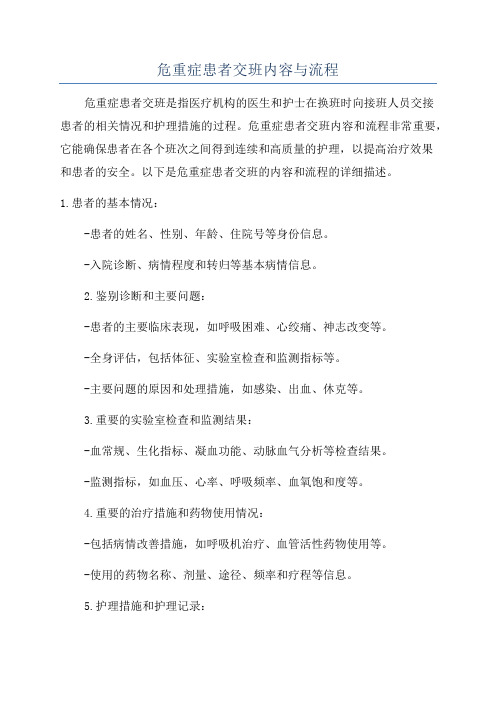
危重症患者交班内容与流程危重症患者交班是指医疗机构的医生和护士在换班时向接班人员交接患者的相关情况和护理措施的过程。
危重症患者交班内容和流程非常重要,它能确保患者在各个班次之间得到连续和高质量的护理,以提高治疗效果和患者的安全。
以下是危重症患者交班的内容和流程的详细描述。
1.患者的基本情况:-患者的姓名、性别、年龄、住院号等身份信息。
-入院诊断、病情程度和转归等基本病情信息。
2.鉴别诊断和主要问题:-患者的主要临床表现,如呼吸困难、心绞痛、神志改变等。
-全身评估,包括体征、实验室检查和监测指标等。
-主要问题的原因和处理措施,如感染、出血、休克等。
3.重要的实验室检查和监测结果:-血常规、生化指标、凝血功能、动脉血气分析等检查结果。
-监测指标,如血压、心率、呼吸频率、血氧饱和度等。
4.重要的治疗措施和药物使用情况:-包括病情改善措施,如呼吸机治疗、血管活性药物使用等。
-使用的药物名称、剂量、途径、频率和疗程等信息。
5.护理措施和护理记录:-护理记录的内容和时间,如观察信息、给药记录等。
-患者的护理问题和护理计划,如床位转换、翻身护理等。
6.危险因素和风险评估:-患者的危险因素,如跌倒风险、感染风险等。
-风险评估和相应的预防措施,以保证患者的安全。
7.医疗团队之间的合作和沟通:-与其他科室和专家的协作情况,如内科、外科、心血管科等。
-主治医生、护士、药师、物理治疗师等之间的沟通和交流的内容和结果。
1.接班人员的准备:-接班人员应提前了解患者的基本信息和病情情况。
-准备笔记、表格和其他需要的交班工具。
2.确保所有必要的交接内容:-提供完整和准确的患者信息和问题列表。
-提供重要的检查结果和监测指标。
3.逐一解释患者的情况和问题:-按照患者的重要性和紧急性的顺序进行交接。
-内容应包括患者的病情、治疗措施和护理计划等。
4.确保沟通的双向性和效果:-接班人员应提问、讨论和确认已交班的内容。
-交班人员应回答问题和解释不确切或不清楚的内容。
产后出血患者的应急预案及流程

产后出血患者的应急预案及流程产后出血是指产后24小时内阴道流血超过500毫升,或产后48小时内阴道流血超过1000毫升的情况。
产后出血是娩出的妇女在产后阴道分娩过程中大量血液的破损引起的。
此情况属于急诊医学范畴,需要迅速采取应对措施。
本文将介绍。
一、应急预案建立:1. 目标:减少因产后出血引起的妇女死亡率,降低产后出血带来的严重后果。
2. 组织机构:建立产后出血应急小组,包括妇产科医生、产科护士、麻醉科医生、输血科医生等。
3. 资源准备:确保有足够的输血产品、药物、设备等急救资源。
4. 预案培训:定期进行应急预案演练,提高团队成员的应对能力。
5. 管理与评估:建立和完善应急预案的管理和评估机制,及时总结经验,不断优化预案。
二、应急流程:1. 早期阶段(产后30分钟内):- 识别患者:产后立即观察出血情况,如果发现大量出血,立即报警。
检查患者的生命体征和血压。
- 创伤评估:立即进行创伤评估,确定是产后出血引起,并排除其他原因引起的出血。
继续观察患者的出血情况和生命体征。
- 快速治疗:立即开启快速血管通路,开始输注生理盐水或乳酸林格液,以恢复有效循环容量。
- 关键诊断:尽快进行关键诊断,确定出血的来源。
可以通过超声、宫颈穿刺、子宫探查等方式进行。
2. 急诊阶段(产后30分钟-2小时内):- 输血支持:确定出血的原因后,开始注射红细胞悬液、新鲜冰冻血浆和凝血因子等输血产品。
根据患者的血压、脉搏等指标调整输血速度和剂量。
- 药物治疗:静脉给予奥曲肽、前列地尔等止血药物,促进血管收缩和凝血功能恢复。
- 停止出血:如患者出血源在宫颈或子宫上段,可以使用缝合或加压止血。
如出血源在子宫下段或阴道,需要立即进行子宫切除术等手术治疗。
3. 并发症处理:- 休克处理:根据患者的情况,给予液体复苏、升压药物等,纠正休克状态。
- 凝血功能障碍:继续输注凝血因子、新鲜冰冻血浆等,同时纠正凝血功能障碍的基础疾病。
- 术后护理:术后密切观察患者的生命体征和血压,防止感染、功能衰竭等并发症发生。
产后出血患者抢救流程演练

2、组织者根据反馈存在的问题,及时改进及调整演练流程;
3、根据改进的流程进行再次演练,演练效果较好。
记录人:
组织者签字:
评价人签字:
组织部门:产房病区 配合部门: 血库
. .
.
存在问题及改进措施:
总结:整体演练效果比较好,人员基本能按时到位,每个人职责明确,物品准备充分,医护合作协调、有效,护士医嘱执行准确,,处理到位,基本达到预期目标。
存在问题:
1、应急状态不强。
2、人员太多,杂乱。
3、物品放置乱。
4、急救车放置位置不妥。
5、口头医嘱复述声音太小。
改进措施:1、现场总结,将存在问题及时反馈给每个人;
实战效果评价
□达到预期目标 ■基本达到目的,部分环节有待改进
□没有达到目标,需重新演练
部门配合Байду номын сангаас作
报告上级 ■报告及时 □报告不及时 □联系不上
配合部门 ■配合、协作好,能及时到达 □配合、协作差,未及时到达
处理结果
■处理到位 □部分处理不到位 □大部分处理不到位
急救意识
□急救意识强 ■急救意识薄弱 □急救意识差
5、患者生命体征平稳、病情稳定抢救结束,整理病室环境,如实补记抢救医嘱及护理病例记录,继续密切观察病情变化,尤其是意识、血压、尿量、子宫收缩情况、阴道流血量及生命体征变化。
6、助产士给予产后健康宣教,相关病情与患者家属沟通。
产后大出血应急预案

一、背景产后大出血是产科常见的严重并发症,如不及时处理,可能导致产妇休克、器官功能衰竭甚至死亡。
为保障母婴安全,提高抢救成功率,特制定本应急预案。
二、组织架构1. 应急指挥部:由医院院长担任总指挥,分管副院长担任副总指挥,各科室负责人为成员。
2. 抢救小组:由产科、麻醉科、输血科、儿科等相关科室医护人员组成。
3. 后勤保障组:负责提供抢救所需物资、设备等。
三、应急响应流程1. 发现产后大出血:医护人员发现产后大出血时,应立即启动应急预案,并立即通知抢救小组组长。
2. 启动应急响应:抢救小组组长接到通知后,立即组织人员到位,启动应急响应。
3. 评估病情:抢救小组对产妇进行快速评估,了解出血原因、出血量、休克程度等。
4. 抢救措施:- 止血:根据出血原因,采取相应的止血措施,如宫缩剂、缝合、结扎等。
- 输血:根据出血量,迅速建立静脉通道,给予输血,补充血容量。
- 抗休克:给予氧气吸入,保暖,维持血压稳定。
- 监测生命体征:严密监测产妇的生命体征,如血压、心率、呼吸、体温等。
- 其他措施:根据病情变化,采取其他抢救措施,如药物治疗、器官功能支持等。
5. 转诊:如产妇病情危重,需转诊至上级医院时,应及时做好转诊准备,并确保转运过程中安全。
6. 记录:抢救过程中,应详细记录产妇病情、抢救措施、用药情况等。
四、应急物资与设备1. 抢救药品:宫缩剂、止血剂、抗休克药物、输血制品等。
2. 抢救设备:心电图机、呼吸机、心电监护仪、除颤仪、输液泵等。
3. 其他物资:急救包、氧气、保暖物品等。
五、应急培训与演练1. 培训:定期对医护人员进行产后大出血应急预案的培训,提高其应对能力。
2. 演练:定期组织产后大出血应急演练,检验预案的可行性和有效性。
六、总结与评估1. 总结:每次产后大出血事件发生后,应及时总结经验教训,完善应急预案。
2. 评估:定期对应急预案进行评估,确保其适应性和有效性。
通过本应急预案的实施,旨在提高医护人员对产后大出血的应对能力,降低母婴死亡率,保障母婴安全。
产后出血危重病人交接班流程
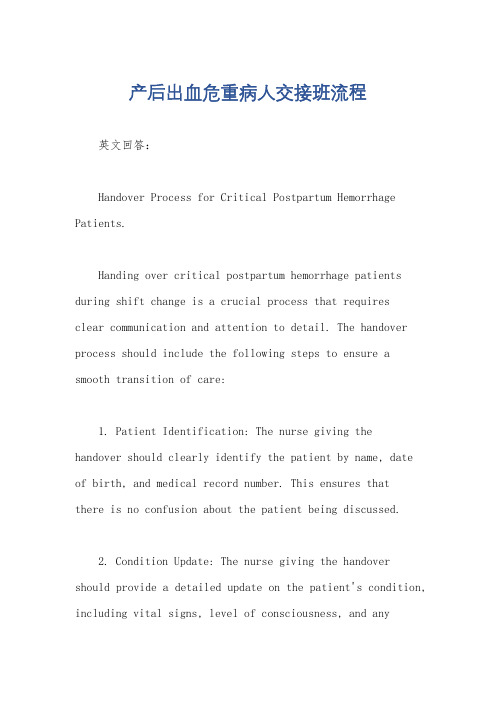
产后出血危重病人交接班流程英文回答:Handover Process for Critical Postpartum Hemorrhage Patients.Handing over critical postpartum hemorrhage patients during shift change is a crucial process that requiresclear communication and attention to detail. The handover process should include the following steps to ensure a smooth transition of care:1. Patient Identification: The nurse giving the handover should clearly identify the patient by name, dateof birth, and medical record number. This ensures thatthere is no confusion about the patient being discussed.2. Condition Update: The nurse giving the handover should provide a detailed update on the patient's condition, including vital signs, level of consciousness, and anyrecent interventions or changes in the patient's status.3. Treatment Plan: The current treatment plan should be clearly communicated, including any medications, blood transfusions, or procedures that the patient has received or is scheduled to receive.4. Critical Incidents: Any critical incidents or near misses that have occurred during the shift should be discussed to ensure that all team members are aware of potential safety concerns.5. Care Priorities: The nurse receiving the handover should be informed of the patient's care priorities, including any specific needs or concerns that require immediate attention.6. Questions and Clarifications: The nurse receiving the handover should have the opportunity to ask questions and seek clarifications about the patient's condition and care plan.7. Confirmation of Understanding: The nurse giving the handover should ensure that the receiving nurse understands the information provided and is prepared to take over the care of the patient.By following these steps, the handover process for critical postpartum hemorrhage patients can help ensure continuity of care and patient safety.中文回答:产后出血危重病人交接班流程。
手术室危重孕产妇转运交接流程

手术室危重孕产妇转运交接流程下载温馨提示:该文档是我店铺精心编制而成,希望大家下载以后,能够帮助大家解决实际的问题。
文档下载后可定制随意修改,请根据实际需要进行相应的调整和使用,谢谢!并且,本店铺为大家提供各种各样类型的实用资料,如教育随笔、日记赏析、句子摘抄、古诗大全、经典美文、话题作文、工作总结、词语解析、文案摘录、其他资料等等,如想了解不同资料格式和写法,敬请关注!Download tips: This document is carefully compiled by theeditor. I hope that after you download them,they can help yousolve practical problems. The document can be customized andmodified after downloading,please adjust and use it according toactual needs, thank you!In addition, our shop provides you with various types ofpractical materials,such as educational essays, diaryappreciation,sentence excerpts,ancient poems,classic articles,topic composition,work summary,word parsing,copy excerpts,other materials and so on,want to know different data formats andwriting methods,please pay attention!手术室危重孕产妇转运交接流程一、转运前准备1. 评估孕产妇的病情,包括生命体征、意识状态、呼吸情况等。
- 1、下载文档前请自行甄别文档内容的完整性,平台不提供额外的编辑、内容补充、找答案等附加服务。
- 2、"仅部分预览"的文档,不可在线预览部分如存在完整性等问题,可反馈申请退款(可完整预览的文档不适用该条件!)。
- 3、如文档侵犯您的权益,请联系客服反馈,我们会尽快为您处理(人工客服工作时间:9:00-18:30)。
产后出血危重病人交接班流程英文回答:
Handover process for critically ill postpartum hemorrhage patients:
1. Introduction:
During the handover process for critically ill postpartum hemorrhage patients, it is essential to provide a comprehensive and organized report to ensure the continuity of care. This handover should include relevant patient information, ongoing treatments, and any immediate concerns or changes in the patient's condition.
2. Patient information:
Begin the handover by providing essential patient information such as name, age, medical history, and obstetric history. Include details about the delivery,
including the type of delivery, any complications, and the estimated blood loss. It is also important to mention any pre-existing medical conditions that may impact the
patient's management.
3. Current condition:
Describe the patient's current condition, focusing on vital signs, level of consciousness, and any signs of ongoing bleeding. Include information about the patient's pain level, fluid balance, and any changes in urine output. It is crucial to highlight any immediate concerns or deteriorations in the patient's condition that require urgent attention.
4. Ongoing treatments:
Provide a detailed account of the ongoing treatments and interventions the patient is receiving. This may include medications, blood transfusions, surgical interventions, or other procedures. Mention any specific monitoring requirements or equipment that is being used for
the patient's management.
5. Laboratory and imaging results:
Include relevant laboratory and imaging results that are crucial for the patient's management. This may include hemoglobin levels, coagulation profile, blood gas analysis, and any imaging studies such as ultrasound or computed tomography scans. Interpret and summarize the results to highlight any abnormalities or changes that require attention.
6. Communication with other healthcare professionals:
Discuss any consultations or communication with other healthcare professionals involved in the patient's care. This may include specialists such as hematologists, anesthesiologists, or interventional radiologists.
Highlight any recommendations or changes in management based on these consultations.
7. Patient and family concerns:
Address any specific concerns or questions raised by
the patient or their family members. This may include information about the prognosis, potential complications,
or any emotional support required. Ensure that any cultural or religious considerations are taken into account during the handover process.
8. Action plan:
Summarize the current action plan for the patient, including any pending investigations, ongoing treatments, and planned interventions. Clearly communicate any specific instructions or tasks that need to be completed by the receiving healthcare team.
9. Closing remarks:
End the handover by expressing gratitude for the collaboration and teamwork involved in managing the patient. Encourage open communication and emphasize the importance
of regular updates and feedback between the healthcare team
members.
中文回答:
产后出血危重病人交接班流程:
1. 介绍:
在产后出血危重病人交接班过程中,提供全面有序的报告非常
重要,以确保连续的护理。
这个交接班应包括相关的病人信息、正
在进行的治疗以及病人状况的任何即时关注或变化。
2. 病人信息:
开始交接班时,提供基本的病人信息,如姓名、年龄、病史和
产科病史。
包括有关分娩的详细信息,包括分娩方式、任何并发症
和估计的失血量。
还要提及可能影响病人管理的任何既往疾病。
3. 当前状况:
描述病人当前的状况,重点关注生命体征、意识水平和任何持
续出血的迹象。
包括病人的疼痛程度、液体平衡和尿量的任何变化。
重点强调任何需要紧急关注的即时关注或病人状况恶化的情况。
4. 正在进行的治疗:
详细介绍病人正在接受的持续治疗和干预措施。
这可能包括药物、输血、手术干预或其他程序。
提及为病人管理而使用的任何特
定监测要求或设备。
5. 实验室和影像结果:
包括对病人管理至关重要的相关实验室和影像结果。
这可能包
括血红蛋白水平、凝血功能、血气分析以及超声或计算机断层扫描
等任何影像研究。
解释和总结结果,强调任何需要关注的异常或变化。
6. 与其他医疗专业人员的沟通:
讨论与病人护理相关的任何咨询或与其他医疗专业人员的沟通。
这可能包括血液学家、麻醉师或介入放射学家等专科医生。
强调基
于这些咨询的任何建议或管理变化。
7. 病人和家属关注:
解决病人或家属提出的任何具体关注或问题。
这可能包括有关
预后、潜在并发症或任何需要的情感支持的信息。
确保在交接班过
程中考虑到任何文化或宗教因素。
8. 行动计划:
总结病人的当前行动计划,包括任何待定的调查、正在进行的
治疗和计划的干预措施。
清楚地传达给接收医疗团队需要完成的任
何具体指示或任务。
9. 结束语:
结束交接班时,对参与病人管理的合作和团队合作表示感谢。
鼓励开放沟通,并强调医疗团队成员之间定期更新和反馈的重要性。
